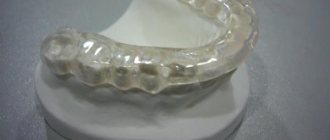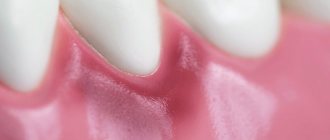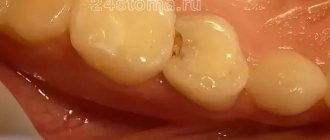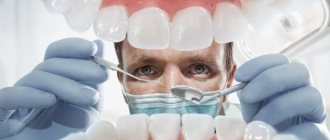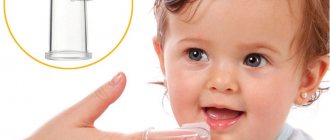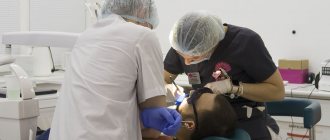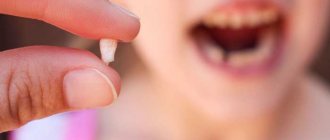Malocclusion and crooked teeth in children are a fairly common problem that requires orthodontic correction. In modern dentistry, braces are successfully used to gradually move teeth into the correct position. Wearing these structures allows you to achieve excellent aesthetic and physiological results.
In this article we will look at at what age to install and how to choose braces for a teenager
, the main criteria for evaluating the design and how much braces cost in Moscow.
Optimal age for installing braces
It is better to start orthodontic treatment in early adolescence, since correcting the bite in children 12-14 years old is much easier and faster than in older patients.
It is not advisable to install braces if the child still has baby teeth. Closer to 11-13 years, the process of loss of milk teeth and the growth of permanent teeth ends. This period is considered the most optimal for installing braces. Teeth can still be easily corrected, and thanks to the active growth of the jaw, orthodontic structures can effectively influence the position of teeth and form an ideal smile.
The best time to install braces will be determined by an experienced orthodontist after studying the features of the young patient’s dental system.
How does the treatment of pulpitis of permanent teeth in children and adolescents differ from the treatment of adults?
Newly erupted “young” permanent teeth do not yet have formed roots. Therefore, if pulpitis in a teenager is to be treated, the doctor must first find out, using x-rays, whether the roots of the diseased tooth have formed or not. If the roots are not formed, then the treatment of the tooth canals is carried out as sparingly as possible.
Unfortunately, the method of partial removal - amputation of the pulp, which is often described on dental websites as acceptable in this case, does not work well in practice. It gives too many complications and a 100% guarantee that the tooth canals will need to be re-treated, so this method of treatment is practically not used in our clinic.
You also need to remember that if you do not seek dental care in a timely manner or if a doctor makes a mistake, pulpitis in adolescents quickly becomes complicated and turns into purulent forms, periodontitis (inflammation of the tissues surrounding the tooth) and even sepsis (blood poisoning).
How to choose braces for a teenager?
The most important question for parents who want the best for their child is what braces to get for their teenager.
? Currently, there are several types of brace systems, distinguished by material, method of fastening and location of the structure in the dentition.
Types of braces according to installation method:
- vestibular – fixed to the outer surface of the teeth (cheek).
- lingual – installed on the inner side of the teeth (lingual).
By type of construction:
- self-regulating – provide a uniform load on the dentition;
- ligature – create an uneven load on the teeth, which can cause pain.
According to the material:
- metal - the most common designs, reliable and inexpensive, but less aesthetically pleasing;
- ceramic – characterized by high aesthetics, invisible in the oral cavity, but quite fragile and require careful use;
- plastic – reliable, invisible on the teeth, but can cause allergies and are susceptible to staining when exposed to food;
- sapphire - durable and aesthetic designs with many advantages, but the most expensive.
A molecular mechanism has been discovered that stimulates tooth growth in mice
How lucky it is that when a small child loses a tooth, a new one grows in its place in a matter of months. If only adults could count on such luck too. Recent work by researchers at Kyoto University and Fukui University gives us hope for teeth-growing technology.
The authors of the work reported that antibodies to the USAG-1 gene (a gene associated with intrauterine sensitization) are able to stimulate the growth of missing teeth in mice if this is associated with congenital pathology.
Despite the fact that an adult usually grows 32 teeth, approximately 1% of the population is faced with the congenital absence of some teeth, or, on the contrary, with the growth of supernumerary teeth. Until recently, scientists tried to determine the reason for the growth of a larger set of teeth, searching for mechanisms that could later be used to regenerate them.
The author of the work, Katsu Takahashi, who teaches at the Kyoto University School of Medicine, believes that the scientific world has already succeeded in identifying the fundamental molecules responsible for the process of tooth formation. “Tooth morphogenesis in a given individual depends on the interaction of a number of molecules, the most important of which are the bone morphogenetic protein BMP and the Wnt signaling pathway.”
Interestingly, these proteins affect not only the process of tooth formation. They are also involved in the growth of many organs and tissues at the initial stage of development of the human embryo. Therefore, during pregnancy, doctors do not recommend taking drugs that directly affect the activity of these proteins due to the likelihood of side effects.
The authors suggested that it would be safer to act on factors that suppress the activity of BMP and Wnt proteins, in particular the USAG-1 gene. “We know that suppression of USAG-1 gene function promotes tooth growth, but it is not yet clear whether such a modification can trigger the process of tooth growth,” the authors say.
The researchers looked at several types of monoclonal antibodies that suppress the activity of the USAG-1 gene. The selected antibodies are widely used in the treatment of cancer, arthritis, and for the development of vaccines.
BMP and Wnt proteins have activity against the USAG-1 gene. The experiments revealed that certain types of antibodies lead to high mortality at birth and low life expectancy among mice. Which proves that BMP and Wnt proteins are vital for proper embryonic development. However, it was possible to isolate one type of antibody that suppresses the activity of the USAG-1 gene using only the BMP protein.
In a series of experiments, it was possible to establish that the BMP signaling pathway plays a key role in the formation of a sufficient number of teeth in mice during the embryonic period. A single injection of protein into the blood of a mouse allowed it to grow a full row of teeth. The results of the experiment were also confirmed in the ferret model.
“The formation of the dentition in ferrets is more similar to that of humans – they replace two sets of teeth. Our future plans are to test the theory on other animals, such as pigs and dogs,” the authors say.
This work was the first to prove the possibility of using monoclonal antibodies for tooth regeneration, which in the future may serve as the basis for the development of unique drugs that can replace implantation and prosthetic technologies.
“Conventional technologies for growing artificial tissues and organs are not suitable for dental regeneration. However, we have demonstrated that molecular therapies can address the problem of congenital tooth deficiency, at least in a mouse model,” the authors write.
Main selection criteria
When choosing braces for a teenager, parents need to consider several important points.
Criterias of choice:
- If the speed of treatment is important, then you need to install metal braces to achieve quick results.
- Plastic braces require careful oral care. If the child responsibly follows all the rules of hygiene, then such a system can be installed to correct the bite.
- If a child is embarrassed to wear orthodontic structures, or there is a serious psychological barrier, then it is worth considering the option of installing ceramic braces that are invisible to others.
- If a child is capricious and does not want to give up a number of forbidden foods that can cause damage to the orthodontic system, then it is better to install metal braces, which are characterized by the highest strength.
- Sapphire braces are the best option for installation, but parents will have to spend a lot of money on such a design.
The choice of braces for installation in a teenager should be agreed with the attending doctor. The specialist will help you make the right decision, taking into account the complexity of the clinical case and the patient’s wishes.
How long to wear braces?
Minimum period of wearing braces for teenagers
– 1-1.5 years. In general, the timing of wearing orthodontic systems depends on the complexity of the pathology.
Why do we need a special approach to the treatment of caries and pulpitis in mixed dentition?
A child’s new permanent teeth are very different in structure from the teeth of an adult – they have fragile, not yet mineralized (not saturated with minerals) enamel and unformed roots. In order for a tooth to “mature” it will take from 3-4 months to 1.5 -2.5 years for the mineralization of the enamel, and up to 4 years for the formation of roots. Those. in fact, the formation of full adult teeth is completed by the age of 16.
Until this age, a teenager has “special” teeth, so until the age of 16, he should be treated by a pediatric dentist, no matter how much he would like to be an adult and see an “adult” doctor. Only a pediatric dentist has sufficient skill in treating permanent teeth that have not yet fully formed - he has not only the knowledge for this (any dentist theoretically knows how to treat “young” teeth), but also the necessary daily experience. And the absence of relapses of the disease and complications in the future depends on correctly performed manipulations.
Cost of treatment with braces in Moscow dentistry
The dentist can install high-quality braces. Price in Moscow for a teenager
determined depending on the type of design chosen.
On the website in the “Prices” - “Orthodontics” section you can see how much braces cost for a teenager
different types with installation. There is a discount program and installment plans for orthodontic treatment and other dental services.
All patients who leave reviews on the Aesthetics website are given a 3% discount on all dental services of the center (in addition to other discounts available to the patient).
Advice for teenagers
In order for a young man to smile widely, he needs to monitor and care for his dental health correctly:
- Brush your teeth and floss twice a day to avoid plaque deposits;
- limit the consumption of sweets and starchy foods, create a diet of foods that do not harm teeth;
- undergo regular dental examinations;
- if a malocclusion develops, visit an orthodontist, who will recommend the best treatment option - braces, dental plates;
- if a teenager is involved in active sports, then he should wear protective mouthguards to protect his teeth and gums from injury;
- avoid bad habits such as smoking, which causes plaque deposits, bad breath and can lead to cancer;
- if you want to somehow express yourself and make yourself a piece of jewelry, for example, tongue or lip piercing, you don’t need to do it in unsanitary conditions, it’s better to go to the dentist, talk about your desire, and he will advise what measures should be taken;
- It is impossible to whiten your teeth at home, but you can maintain whiteness after professional whitening with the help of whitening pastes; in no case should you use chemical elements to make your smile snow-white on your own, without the supervision of a doctor.
It is important for parents to understand that teenagers are children, but they cannot simply be ordered around. They need to be taught, mentored, and shown a positive example of a healthy lifestyle. And it is very important to teach him to take care of his oral and dental health and regularly visit the dentist and make visits to the doctor every six months a habit that he will take with him into adulthood.
Other factors
At the age of 13-17, boys and girls strive to try everything that is on the legal and illegal market in order to feel like adults. This desire leads to non-carious lesions of the hard tissues of the tooth. Working at a computer around the clock causes the same consequences, as it creates electromagnetic radiation. It also negatively affects his teeth. If you spend more than 8 hours a day at the monitor, you can earn necrosis of dental tissue. First, the teeth stop shining, then they darken and may turn black. In this process, the dental tissue becomes loose. The strangest thing is that there is no pain. As a result, if you miss the moment, you can lose your teeth. In turn, the removal of permanent teeth leads to deformation of the dentition.
Processes occurring inside the body can also lead to consequences. Hormones from the developing reproductive system can cause gingivitis and even periodontal disease. Therefore, oral hygiene at this time should be treated with maximum attention. It doesn't hurt to brush your teeth after every meal and at least have a quarterly dental check-up.
If you do not resort to these measures, then due to heredity and laziness, you can acquire desmodontosis as an additional disease. The disease is not a pleasant one. When it is present, tissues are destroyed at such a rate that within a few weeks of its appearance, teeth become mobile. And the dynamics, according to tradition, originate from the front teeth. The fair half of humanity is more predisposed to this disease. More than 60% of girls experience it during adolescence, and receive consequences after 20-25 years.
And these are just some of the problems that threaten teenagers’ teeth. It is better to diagnose possible diseases before their active stage begins.
Dental clinic specialists can not only identify a predisposition to certain types of oral lesions, but also prescribe preventive treatment. Without delaying a visit to the dentist, you will save your child’s time and family budget. You can see the dentist at any time convenient for you. Tweet
What are plates and braces used for?
Plates and braces are used to correct a teenager’s bite. And also in order to make your teeth as straight as possible. Both plates and braces are popular dental treatment tools. Although they have huge differences. In terms of efficiency and price.
Differences in design between both types of medical instruments
The main purpose of braces and plates is to make a teenager’s teeth straight. But they achieve it in completely different ways. Both devices have different designs from each other.
Features of records
The plates are removable structures. Because they can be taken out of your mouth at any time. And then insert it back.
The advantage of the plates is that the teenager has the opportunity to remove them at any time. For example, when going to a birthday party. Or to some event at school. Also, the teenager will have to remove the plates at the moment when he washes himself. And also brush your teeth.
The plates are made primarily from a specialized type of plastic. However, some parts of the product can be created from different types of metal. In particular, we are talking about the temples. Special springs. And screws.
Features of braces
Braces are static devices. Taking them off and putting them on is impossible. They are installed by the dentist. And they are filmed by him.
Braces are only used if a teenager has serious dental problems. Severe illnesses or extremely noticeable pathologies.
Each bracket (unit of construction) attaches to one tooth. As strong as possible. So as not to fall off before the teenager completes the course of treatment for crooked teeth. That is, braces must last for at least 12 months. And don't fall off.
Wearing braces has a number of features:
- You will have to wear them around the clock. It will not be possible to remove them during the entire course of treatment. Under no circumstances.
- Braces are visible to people around the teenager. It attracts attention.
- You won't be able to remove braces yourself. The teenager will have to go to the dentist. And remove the structure from him.
Manufacturers use a variety of materials to create braces. Basically, they prefer ceramic products. Which are almost invisible when worn. Therefore, they are convenient for a teenager.
However, all braces have a special arch made of metal. Which negatively affects their appearance.
